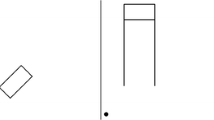Summary
Binary choice reaction time depends on the relationship between the alternative responses. In particular, it is longer when choice is between finger movements of either hand, which have different forms, than when choice is between movements of identical form. This effect can be interpreted in terms of conjunctive preparation. If everything common to both responses is prepared in advance of the response signal, the form of the movement can only be prepared if it is the same for both responses. An alternative interpretation is in terms of single preparation. Under this hypothesis either one or the other response is prepared completely, but in case the not prepared response is demanded by the signal the time needed to shift should be longer if the movements are of different form. Thus, an effect of the form-relation will be seen only in unprepared responses, while under the hypothesis of conjunctive preparation it should be present in prepared responses as well. To decide between both hypotheses relative signal frequency and thus the proportion of expected (and prepared) responses was varied in three experiments. It turned out that the effect of the form-relation is larger with low relative signal frequency than with high frequency. This indicates the existence of single preparation. However, single preparation appears to be incomplete. When the obtained data are extrapolated to a relative signal frequency of 1.0 an effect of the form-relation still remains.
Similar content being viewed by others
References
Bertelson P, Barzeele J (1965) Interaction of time uncertainty and relative signal frequency in determining choice reaction time. J Exp Psychol 70:448–451
Brunia CHM (1980) Motor preparation, recorded on the cortical and spinal level. In: Stelmach GE, Requin J (eds) Tutorials in Motor Behavior. North-Holland, Amsterdam
Fitts PM, Peterson JR, Wolpe G (1963) Cognitive aspects of information processing: II. Adjustments to stimulus redundancy. J Exp Psychol 65:423–432
Heuer H (1982a) Binary choice reaction time as a criterion of motor equivalence. Acta Psychol 50:35–47
Heuer H (1982b) Binary choice reaction time as a criterion of motor equivalence: Further evidence. Acta Psychol 50:49–60
Heuer H (1983) Reaktionszeit und Genauigkeit bei der Wahl zwischen formgleichen und formverschiedenen Bewegungen beider Hände. (in preparation)
Hinrichs JV (1970) Probability and expectancy in two-choice reaction time. Psychonom Sci 21:227–228
Hinrichs JV, Krainz PL (1970) Expectancy in choice reaction time: Stimulus vs. response anticipation? J Exp Psychol 85:330–334
Kendall MG, Stuart A (1963) The Advanced Theory of Statistics. Vol. 1: Distribution Theory. Griffin, London
Kerr B (1978) Task factors that influence selection and preparation for voluntary movements. In: Stelmach GE (ed) Information Processing in Motor Control and Learning. Academic Press, New York
Klapp ST, Greim DM (1979) Programmed control of aimed movements revisited: The role of target visibility and symmetry. J Exp Psychol [Hum Percept] 5:509–521
Kornblum S (1965) Response competition and/or inhibition in two-choice reaction time. Psychonom Sci 2:55–56
LaBerge D, Tweedy JR (1964) Presentation probability and choice time. J Exp Psychol 68:477–481
Marteniuk RG, MacKenzie CL (1980) Information processing in movement organization and execution. In: Nickerson RS (ed) Attention and Performance VIII. Erlbaum, Hillsdale, NJ
Requin J (1969) Some data on neurophysiological processes involved in the preparatory motor activity to reaction time performance. In: Koster WG (ed) Attention and Performance II. North-Holland, Amsterdam
Requin J (1980) Towards a psychobiology of preparation for action. In: Stelmach GE, Requin J (eds) Tutorials in Motor Behavior. North-Holland, Amsterdam
Rosenbaum DA (1980) Human movement initiation: Specification of arm, direction, and extent. J Exp Psychol 109:444–474
Rosenbaum DA, Kornblum S (1982) A priming method for investigating the selection of motor responses. Acta Psychol 51:223–243
Sternberg S, Monsell S, Knoll RL, Wright CE (1978) The latency and duration of rapid movement sequences: comparisons of speech and typewriting. In: Stelmach GE (ed) Information Processing in Motor Control and Learning. Academic Press, New York
Author information
Authors and Affiliations
Additional information
This research was supported by Deutsche Forschungsgemeinschaft (grants No. He 1187/1 and 1187/2-1)
Rights and permissions
About this article
Cite this article
Heuer, H. Choice between finger movements of different and identical form: The effect of relative signal frequency. Psychol. Res 44, 323–342 (1982). https://doi.org/10.1007/BF00309328
Received:
Published:
Issue Date:
DOI: https://doi.org/10.1007/BF00309328




